-
Practice integrating platforming challenges with evolving mechanics such as jumping, gliding, and bouncing
-
Build a linear space with strong player guidance
-
Refine pacing and composition to keep traversal engaging
-
Add light narrative flavor that supports the design without overcomplicating mechanics
-
Emphasize player character feedback so progress feels rewarding and mistakes are clearly communicated
ASSETS USED
I worked with a mix of custom assets and placeholder packs. For the main pieces like cliffs and ground meshes, I built simple organic shapes in Blender and then tweaked them with Unreal’s Modeling Tool to add variation. For smaller detail assets, I used ones I found on Fab and CGTrader. Those include:
-
Unreal Learning Kit Games (Art & Character)
-
Stylized Eastern Village Pack (Art)
-
Level Design Kit (Art)
-
FreeSound (Audio)
EARLY STAGES

REFERENCE GATHERING
References I gathered during the early stages of the level. They inspired the whimsical style and gave me the idea of combining crystals, floating islands, and mechanical gears, which later became a big part of the level.


ROUGH SKETCHES
I created rough sketches to map out the main player paths and establish the key gameplay beats of the level. These sketches guided the initial blockout
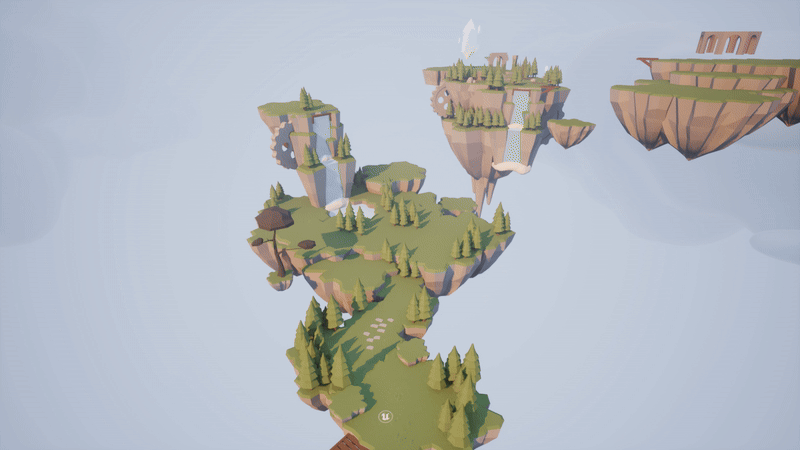
BLOCKOUT
Once I moved into the engine, the focus was all about testing player flow. My sketches gave me a starting point, but I quickly realized some areas felt too rushed, so I rebuilt sections to slow things down and give each moment room to land.
After finishing the blockout I created digital maps for readability and to practice translating my sketches into a polished format. Alongside the overview, I made breakout maps for each section to add more detail and clearly communicate ideas like shard paths, hidden treasures, NPC villagers, and main gameplay beats. This wasn’t part of iteration, but a way to make sure my ideas stayed clear and easy to share in a team setting.
MAP BREAKDOWN




MECHANICS
CRYSTAL PUZZLES
The core gameplay loop is built around collecting shards and restoring crystal boxes. Each time the player repairs a box, the world responds by fixing itself and opening the way forward. This mechanic heavily influenced the level layout since it served as the main player focus.

GEARS OF THE HOLLOW SKY
Fantasy Inspired Adventure Platformer
LEARNING GOALS
OVERVIEW
Gears of the Hollow Sky started as my Week 4 assignment in CGMA’s Level Design course, where I focused on platforming and traversal. I later expanded it into a more complete experience set in a whimsical floating city, using platforming challenges to drive progression.
This project was a chance to hone my skills in traversal design, light exploration, and player guidance, with an emphasis on pacing and level flow.
PROJECT DETAILS
-
Engine: Unreal Engine 5
-
Language: Blueprints
-
Team size: Solo Project
-
Role: Level Designer
-
Duration: 2 weeks
I added a glide mechanic to create fresh platforming sequences that felt fun and engaging. It let me control pacing, keep traversal intentional, and challenge players to glide across larger gaps.
JELLY BOUNCE
I added the Jelly Bounce mechanic to bring a new playful twist to platforming and explore verticality beyond simple jumping and gliding. The mechanic was a small and effective way to keep movement fresh while fitting the whimsical theme of the level.

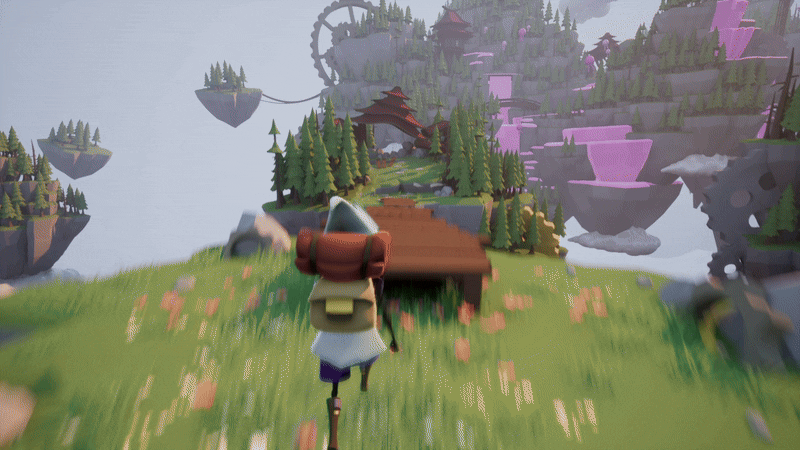


NARRATIVE & UI ELEMENTS
I added simple UI prompts and NPC dialogue to support gameplay flow. NPCs delivered quick story beats and handled tutorials, like teaching gliding or hinting at what to do next.
GLIDING
LEVEL WALKTHROUGH

START AREA & FIRST PUZZLE
I wanted the intro to feel simple but meaningful, so I started with a quick narrative setup through an NPC before introducing the crystal energy box and shard collection loop.
Collecting the shards restores the box and brings the waterfall back to life. This creates a strong first moment where players feel their actions directly shape the world.

GLIDE TUTORIAL
After the intro, I added a short transition space that gave players a breather before the next puzzle. I also used this section to reinforce the player’s goal and introduce gliding as a new way of traversal.
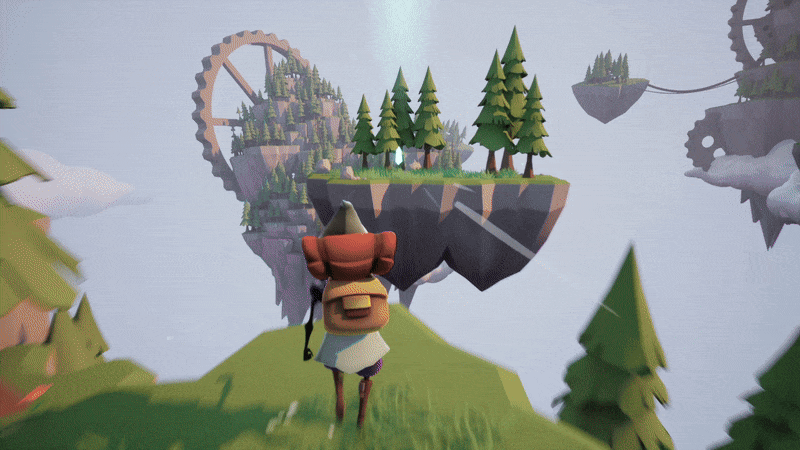
SECOND CRYSTAL CHALLENGE
I wanted this section to feel more challenging and give players a more varied platforming experience by mixing in jumping and gliding traversal. Restoring the crystal box rotates an island back into place, reopening the main path forward.
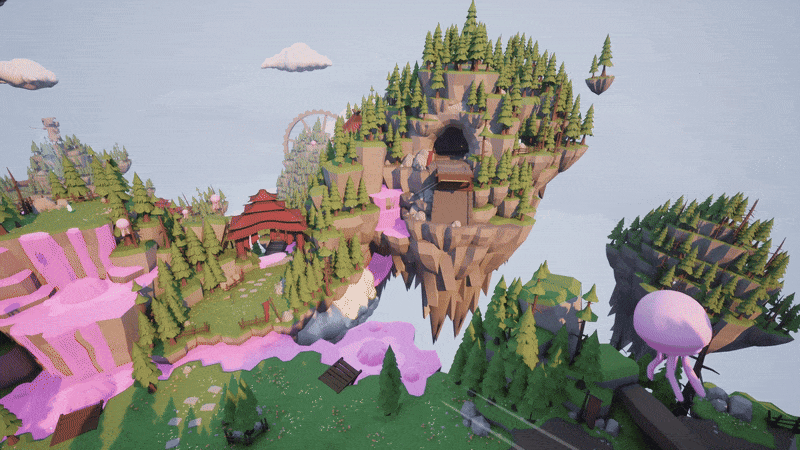
THIRD CRYSTAL CHALLENGE
I wanted this area to stand out, so I introduced the new Jelly Bounce mechanic on a colorful island that felt different from the earlier spaces. The player has to use the Jelly on the ground to reach crystal shards in elevated areas.

FINAL CHALLENGE
I added a short final test before the ending to make the finale feel more rewarding. This was designed as the hardest platforming moment, bringing together jelly bounces and glides for the final test. Originally I planned to end the level sooner, but this extra moment gave the whole experience a stronger conclusion.

FINALE
After the Grand Challenge, players arrive at the crystal core for the closing sequence. I wanted this to be a powerful payoff where the player completes their goal and restores the silent gears of the floating city. Making the gears start to rotate and the villagers cheering is a nice touch to demonstrate this.
LEVEL PLAYTHROUGH
CLOSING THOUGHTS
This project was a great learning experience in building a platforming-focused level. It gave me valuable practice refining pacing and flow while shaping the player experience through environmental cues, audio, and UI. I also pushed myself into areas I don’t usually touch, like sequencers and Blueprints, which gave me hands-on practice outside my comfort zone. Overall, I’m happy with how it came together and feel it strengthened both my creative and technical skills.
In conclusion, this level was an amazing experience where I got to hone both my design and technical skills. I can definitely see myself working on a similar level in the future.
Thank you for reading!
DESIGN TECHNIQUES
DRAWING THE EYE
I used wind VFX and moving flags to subtly draw the player’s eye toward the next jump or objective. Early on, I noticed some areas made it unclear where to go, so adding these moving elements helped guide navigation and made traversal feel more natural during testing.

REWARDING EXPLORATION
Even though the level follows a linear flow, I added small side paths that lead to hidden treasure chests. I wanted to create these moments to reward curiosity and break up the main path so the experience feels more dynamic and less predictable.
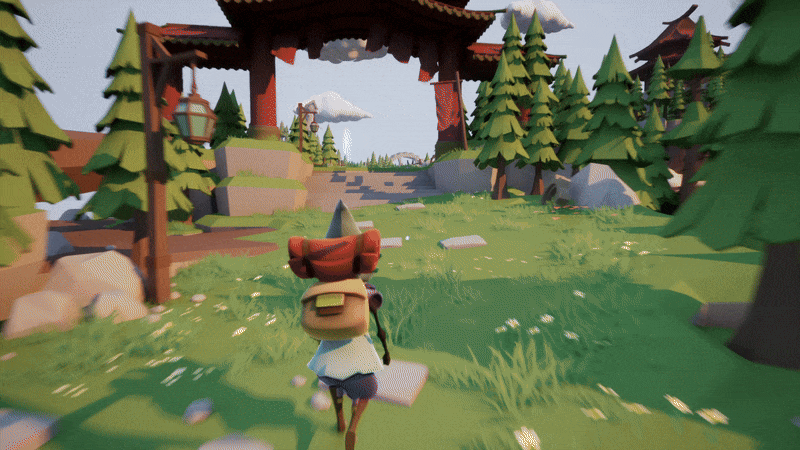
FRAMING OBJECTIVE
I wanted to highlight the importance of the crystal box right from the start. In this opening area, I used trees and rocks as natural framing to draw the player’s attention toward it. Since this was such a key part of the level, I wanted players to immediately gravitate toward the goal. I used the same approach in other spots, relying on negative space and the environment to guide direction without extra UI.
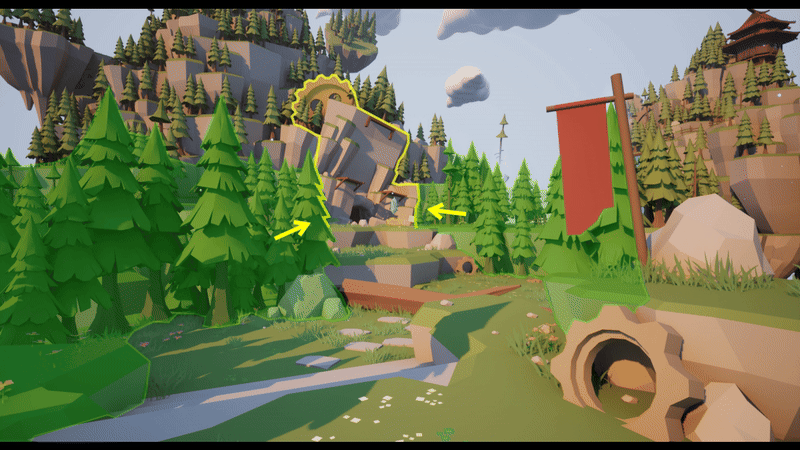
LEADING LINES
Throughout the level I used natural lines to guide direction and pull the player’s eye forward. Fences, planks, and broken props subtly angle toward the next area, creating a clear sense of direction without feeling forced. It’s a small detail, but one that really helped keep the flow of the level smooth and readable.
